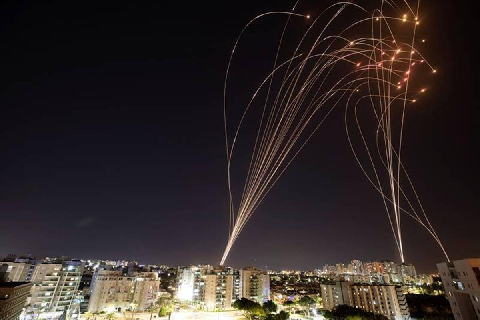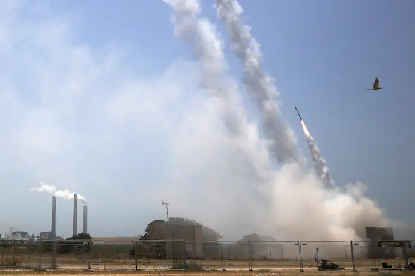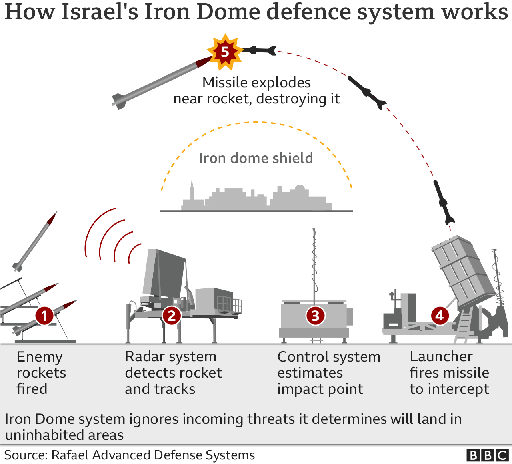A Hamas Unmanned Aerial Vehicle (UAV) that crossed from Gaza into Israel was recently intercepted by the Iron Dome aerial defence system. Hamas has launched over 1,500 rockets from Gaza into Israel in the last few days, according to the Israeli Defence Forces. Iron Dome interceptor missiles have been lighting up the night sky over Israel, shooting down incoming rockets.

What exactly is Iron Dome?
- Iron Dome is a multi-mission system that can detect missiles, artillery, mortars, and Precision Guided Munitions such as very short-range air defence (V-SHORAD) systems, as well as planes, helicopters, and unmanned aerial vehicles (UAVs) over short ranges of up to 70 kilometres. It's an all-weather system that can engage several targets at once and can be deployed both on land and at sea.
- Rafael Advanced Defence Systems Limited manufactures Iron Dome, which has been in service with the Israeli Air Force since 2011. Elta is the company that produced the radar system. After a series of rocket attacks on Israel by Hezbollah and Hamas in the 2000s, it was created.
- Approximately 4,000 rockets were fired on northern Israel during the 2006 Lebanon war, killing 44 Israeli civilians and forcing the evacuation of about 250,000 people.
The Iron Dome missile system has the following features:

- Iron Dome is made up of three main components: a radar for detection and tracking, a combat management and weapon control system (BMC), and a missile launcher (MFU). Elta, an Israeli defence firm, developed the radar system.
- Rafael hired an Israeli software firm, mPrest Systems, to construct the control system.
- Tamir interceptor missiles were among the missiles fired by Iron Dome's MFU.
- It is fitted with electro-optic sensors and has multiple steering fins for high manoeuvrability. The missile system has day-and-night and all-weather capability, as well as a quick reaction time and the ability to intercept salvos. It can also respond quickly to changing threats and manage several threats at once.
- A vertical launch interceptor, warhead and proximity fuse, mobile launcher, and compatibility with various radar and detection systems are among the other features of the Iron Dome. The system's unique warhead enables it to destroy every target in the air.
- Iron Dome radar tracks the rocket's course after detecting and marking it. The system's BMC analyzes the threat's path and calculates an expected point of impact based on the radar data.
- If the determined trajectory of the approaching rocket poses a real danger, an order is issued to launch an interceptor. The incoming rocket explodes over a safe zone.
Who is the inventor of the Iron Dome?
- Israel Aerospace Industries and Rafael Advanced Defence Systems collaborated on this.
- “This is a multi-purpose combat-proven system,” the companies say. Incoming artillery such as thick salvos, cruise missiles, precise guided missiles, and incoming artillery such as C-RAM, UAVs, and Air-Breathing Threats (ABTs) can be detected, assessed, and intercepted with this device.
- It's weatherproof and can function at any time of day or night.
What is the mechanism behind Iron Dome?

- A war management control unit, detection and tracking radar, and a firing unit of three vertical launchers of 20 interceptor missiles each make up an Iron Dome battery. The target warhead is detonated in the air by the interceptor missile using a proximity fuse. Iron Dome is part of a layered defence framework that includes David's Sling and Arrow missile defence systems, which are intended to defend against medium and long-range attacks.
- One of the system's key advantages, according to a 2013 research paper titled "Lessons from the Iron Dome" in Military and Strategic Affairs by Yiftah S. Shapur, is its ability to detect the threatening rocket's expected point of impact, determine whether it will fall in a built-up area or not, and assess whether or not to engage it on that basis. According to the paper, this avoids unnecessarily intercepting rockets that will fall in open areas and thus do no harm.
- So far, the device has intercepted thousands of missiles, with a success rate of over 90%, according to Rafael. The I-DOME is a mobile version that includes all components on a single vehicle, while the C-DOME is a naval version that can be deployed on ships.
History & Development of the Iron Dome mobile air defence system:
- During the Second Lebanon War in 2006, Hezbollah launched missiles, prompting the construction of the Iron Dome. Nearly 4,000 rockets were fired on Haifa and other northern Israeli cities, the majority of which were short-range Katyusha rockets.
- In the attack, approximately 44 Israeli civilians were killed, and approximately 250,000 people were evacuated and moved to other areas of Israel.
- More than 4,000 mortars and rockets (mostly Qassams) were fired into southern Israel from Gaza between 2000 and 2008. With the addition of 122mm Grad launchers, the Qassam's range was extended, bringing nearly one million southern Israelis within range.
- In February 2007, the Israeli Defence Ministry agreed to build a mobile air defence system in response to rocket attacks.
- In March 2009, the missile defence system was successfully evaluated. Without physically intercepting a missile or rocket, the tests were conducted. The machine successfully intercepted a range of rockets during a defence ministry test in July 2009.
- In August 2009, the IAF formed a new battalion to run the Iron Dome system. In a test conducted in January 2010, several rocket bombardments resembling Qassams and Katyushas were successfully intercepted.
- In July 2010, the Iron Dome underwent its final testing. Only incoming missile threats were successfully identified and intercepted by the system, while missiles heading into open fields were not.
- In August 2011, Raytheon partnered with Rafael to commercialize the Iron Dome weapon system in the United States. In September 2014, Rafael awarded Raytheon a $149 million contract for the supply of Tamir interceptor components for the system. In August 2020, Raytheon and Rafael formed a new joint venture called Raytheon Rafael Area Protection Systems to construct an Iron Dome production facility in the United States.
How effective is Iron Dome at preventing attacks?

- Thousands of rockets and artillery shells have been intercepted by the device, according to Israeli officials and security firms, with a success rate of more than 90%.
- Some security analysts, however, cast doubt on those statistics, claiming that Israeli figures for effective interceptions are inaccurate and that groups such as Hamas and Islamic Jihad, which fire rockets and artillery from Gaza, have become accustomed to the device.
- In a 2019 evaluation for the National Interest, Michael Armstrong, an associate professor at Brock University who has researched the system's effectiveness, wrote, "No missile defence system is perfectly reliable, particularly against an emerging threat."
What are the Iron Drone system's limitations?
- So far, the device has worked admirably. When confronted with a barrage of missiles, however, the machine recognizes its limits. “There is a ‘saturation point' in the scheme. It can only engage a limited number of targets at a time (which has yet to be determined).
- Experts believe that additional rockets fired in a crowded salvo could breach defences and cause harm.
- According to several reports, Hamas is developing mitigation techniques such as lowering missile trajectories while continuing to amass thousands of rockets with increased precision.
- One of the system's potential drawbacks, according to experts, is its inability to deal with very short-range threats, as the Iron Dome's minimum interception range is estimated to be 5-7 kilometres.
- Another consideration is the high cost of interception. Experts estimate that the interceptor missile would cost between $40,000 and $50,000.
Upgrades and further testing:
- The Iron Dome missile defence system has been modified to be able to shoot down several complex threats at the same time, such as missiles, unmanned aerial vehicles, and missile salvos.
- The technical upgrade was put to the test in three stages, the most recent of which took place in March 2021 in southern Israel.
- Targets that simulated current and emerging threats were successfully intercepted and destroyed by the Iron Dome.
- The improved version will be delivered to the Israeli Air Force and the Israeli Navy for operational use by Rafael and the Israeli Ministry of Defence.
- In December 2020, Israel conducted a series of live-fire exercises involving the Iron Dome, David's Sling, and Arrow arms systems as part of a multi-layered air defence system.
The mobile air defence system has stirred international interest:
- The new short-range missile defence system aids in the defence of Nato forces in Iraq and Afghanistan.
- In May 2018, Romania's Romero collaborated with Rafael for the manufacture of the Iron Dome system in Romania.
- The US Army completed a contract to buy two Iron Dome systems in August 2019. The second battery was sent to the United States in January 2021.
- Azerbaijan and India have also signed agreements to buy the missile system.
- The Israeli government is in discussions with many European countries about selling the device.











0 Comments